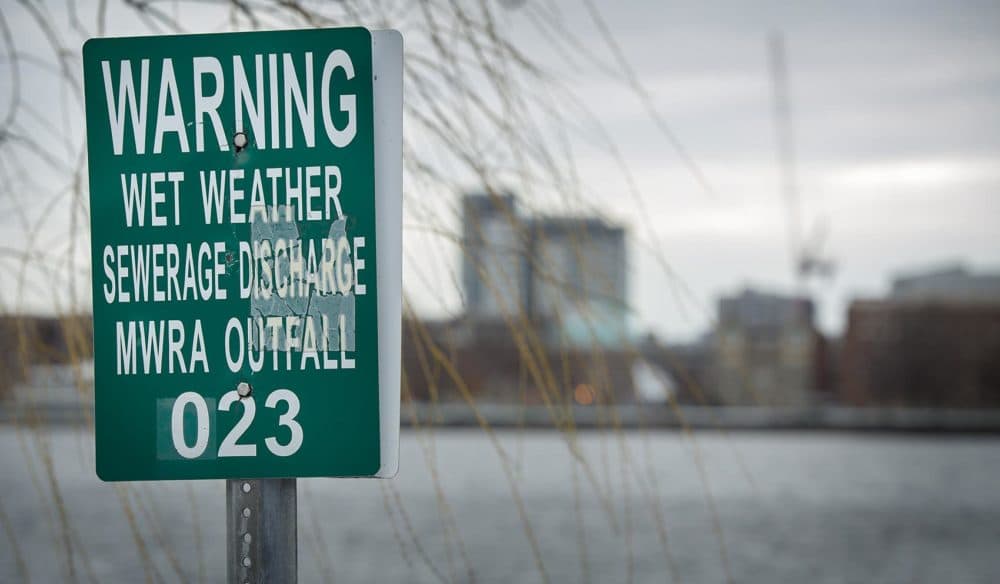Advertisement
Baker: Let’s Use Federal Dollars To Fix Overflowing Sewers

The first half of July gave Gov. Charlie Baker and his administration more than two dozen new examples of sewage being dumped into public waterways after heavy rain that they can point to as they continue to make the case that federal aid should be put to immediate use to deal with the problem.
Within the Massachusetts Water Resources Authority service zone alone, nearly 30 instances of sewage and rainwater being expelled from the wastewater system into bodies of water were reported in the first two weeks of July, a stretch that saw unusually high precipitation. For weeks, Baker has been trying to get the Legislature to release some of the state's $5.3 billion in American Rescue Plan Act money to deal with sewage discharges.
"What I worry about on that one is we miss the opportunity to make those investments because we just, you know, the clock runs out," Baker said Tuesday during a hearing on his federal aid spending plan, which includes $400 million to modernize water and sewer infrastructure.
"In addition to that, just the fact that every time we have a horrible rainstorm we continue to see very significant pollution into those rivers and those bodies of water. And here's a great opportunity for us to do something about that and start working on it now."
Parts of Massachusetts — Boston, Cambridge, Chelsea and Somerville within the MWRA service area — have combined sewer systems, in which surface runoff is put through the same pipes as sewage. When it rains a lot, stormwater and groundwater overwhelm the systems. To prevent sewage backups into homes and streets, relief points called combined sewer overflows (CSOs) that are built into the wastewater systems are activated and discharge some of the sewage and rainwater into the nearest body of water.
Though 93% of its CSO flows are treated through screening, disinfection and dechlorination, the MWRA said, CSO discharges can carry bacteria and cause algae bloom. The issue is a major concern along the Merrimack River and in the Greater Boston area.
People who swim after rainstorms, "do in fact have adverse public health outcomes" because of CSO releases, Secretary of Energy and Environmental Affairs Kathleen Theoharides said Wednesday.
In the 13 days between June 30 and July 12, the MWRA's wastewater system received 11.17 inches of rainfall — about a quarter of the annual average rainfall, Executive Director Fred Laskey wrote in a memo presented at a board meeting Wednesday. The July 1-2 storm dropped the most precipitation, 3.46 inches, followed by the July 9 tropical storm that showered the area with 2.89 inches of rain.
"To add some perspective, Deer Island's flow in June was 291 million gallons per day and just between June 30 and July 12, it averaged 588 MGD," David Duest, director of the Deer Island Treatment Plant, said during the meeting. "In other words, over twice June's flow."
Only three days in the 13-day window saw no measurable rainfall, according to the MWRA's accounting, and the rapid succession of storms limited the ability of the wastewater system to fully recover before more water arrived, leading to numerous discharges from CSOs.
During those 13 days, the MWRA reported 29 CSO discharges of an estimated 309.15 million gallons into various waterways like the Charles River, Mystic River and Fort Point Channel.
"These last few weeks of endless rain have demonstrated just how critical it is to address this issue and to address it now," Baker told lawmakers Tuesday.
In February, the governor signed a law that, starting next July, will require sewer system operators to issue public advisories within two hours of a discharge and every eight hours until the discharge has ended, with a final advisory within two hours of its conclusion.
More from WBUR
At the time of the signing, advocates said that about 3 billion gallons of raw or partially treated sewage are discharged to the state's waterways each year.
The recent heavy rainfall also affects the drinking water side of the MWRA, though not to nearly the same degree.
The Quabbin Reservoir was at 94.1 percent of its 412 billion gallon capacity as of July 1 and began spilling — essentially overflowing in a controlled manner — as of 2 a.m. Tuesday, MWRA chief operating officer David Coppes said.
"The water operations staff have been working seven days a week, releasing as rivers recede to try to maintain freeboard in all of our reservoirs, but in a manner so that we're not contributing to flooding conditions downstream," he said.
Coppes said the Quabbin is about three-quarters of a foot higher than normal for this time of year. And instead of water levels dropping as normally occurs in the middle of the summer, "they're rising rapidly," he said.
"We just started spilling ... it's not spilling a lot yet, but Quabbin is like a big freight train. It takes a lot of momentum to get it moving [and] once it starts to pull, it rolls for a really long time," Coppes said. "So we'll probably see spilling going on for quite a period of time before we get recovery there."
In 2006, the MWRA said, the Quabbin spilled for 306 consecutive days.